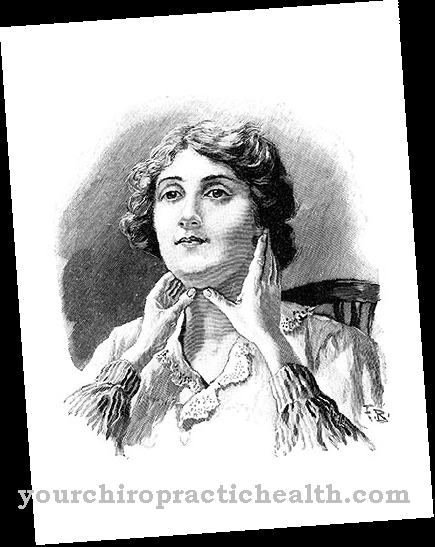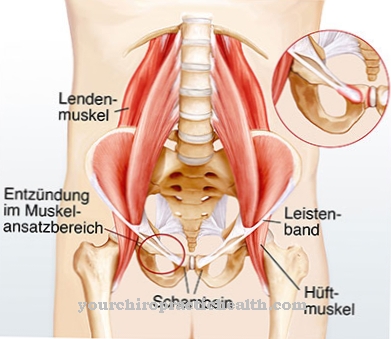The Wartenberg syndrome is a complex of symptoms caused by compression of the radial nerve on the forearm. The syndrome is limited to compressions of the sensory nerve branches and therefore does not cause any motor disorders, but only disorders of sensitivity. Treatment depends on the severity.
What is Wartenberg Syndrome?
The radial nerve is a plexus of the arm. As a mixed nerve, it is responsible for the motor innervation of various arm muscles and the sensitive innervation of various skin areas. It is divided into a motor and a sensitive branch. The sensitive branch is also known as the superficial ramus. The Wartenberg syndrome occurs when the radial nerve is compressed.
Nerve compression syndrome is also called Cheiralgia paraesthetica known and associated with sensory disorders in the skin areas of the extensor thumb and forefinger as well as sensory disorders of the intermetacarpal space. Wartenberg syndrome was first described in the 1930s. Robert Wartenberg is considered the first to describe it.
Wartenberg syndrome must be distinguished from radial paralysis, which is not necessarily caused by peripheral mechanical nerve damage, but also by central nerve lesions and thus affects the brain, the spinal cord or the motor branch of the radial nerve.
causes
Wartenberg syndrome results from an injury Ramus superficialis of Radial nerve. It is an isolated damage that does not affect the entire radial nerve, but only its sensitive branch. In most cases, an isolated lesion of the superficial branch is preceded by impact injuries or cuts that are located dorsally and radially on the distal forearm.
In individual cases, the damage is mechanical compression injuries caused by shackles, bracelets or handcuffs. Sometimes the lesion is caused by intravenous injections or shunt surgery in the area between the cephalic vein and the radial artery.
Plaster restorations that are too tight can also compress the superficial ramus on the radial nerve and thus cause Wartenberg syndrome. Due to the causal connection with shackles, the syndrome is also called Bondage syndrome known. In individual cases the symptom complex is associated with diabetes mellitus.
Symptoms, ailments & signs
Patients with Wartenberg syndrome suffer from a complex of different symptoms. The main symptoms of the syndrome are sensory disturbances such as hypesthesia, hypalgesia and dysesthesia, which mainly occur in the region of the interosseous space I and are therefore clearly in the sensitive supply area of the radial nerve. The Wartenberg syndrome does not necessarily have to be associated with subjectively significant complaints.
Many patients find themselves almost asymptomatic. Motor symptoms such as movement disorders or paralysis of the arm muscles are never associated with the syndrome, since the motor branch of the radial nerve is completely intact. In individual cases, the syndrome can cause more or less severe pain that can spread to the entire arm. If Wartenberg syndrome is caused by handcuffs, additional symptoms may be present.
The blood flow in the compressed area can also be affected by compressions, for example. Such compressions of blood vessels can lead to reduced blood flow and ultimately even necrosis due to an insufficient supply of oxygen and nutrients. In some cases, the symptoms of Wartenberg syndrome were limited to pain. In such a case there are no sensory disorders and the symptoms are similar to de Quervain's tendovaginitis stenosans.
Diagnosis & course of disease
The doctor makes the diagnosis of Wartenberg syndrome on the basis of the clinical symptoms. He examines the patient for the so-called Hoffmann-Tinel sign, which is positive in the case of Wartenberg syndrome. The Finkelstein test can also turn out positive in individual cases. A positive Finkelstein test, however, is not a mandatory characteristic of the disease. Electronurography can be useful for diagnostics.
Using this method, a Wartenberg syndrome can be differentiated from both carpal tunnel syndrome and other types of damage to the radial nerve. The prognosis for patients with Wartenberg syndrome is significantly more favorable than that of patients with lesions of the central nervous system. Peripheral nerves may be able to fully recover from damage.
Complications
Wartenberg syndrome can cause various complications in its course. Typically occurring sensory disturbances such as hypesthesia restrict the person concerned considerably in his everyday life, since everyday stimuli are no longer properly absorbed. Feelings of numbness are a typical side effect and cause significant restrictions on movement if they occur in the arms or legs.
Furthermore, symptoms of the eyes and / or ears can occur, such as visual disturbances or hearing problems. In individual cases, the syndrome causes severe, mostly chronic pain, which further reduces well-being. Circulatory disorders, such as those that occur in Wartenberg syndrome, can lead to reduced blood flow and ultimately necrosis. The affected body region is then permanently paralyzed or the respective limb even has to be amputated.
Surgical treatment can lead to additional damage to the affected nerves. There is also a risk of nerve inflammation. If the wound is not properly cared for after the procedure, wound healing disorders can occur.
This in turn results in scars and adhesions. The accompanying drug therapy can cause discomfort if the patient has an allergic reaction to one of the prescribed preparations. In general, various side effects and interactions may also occur.
When should you go to the doctor?
The person affected should definitely consult a doctor with Wartenberg syndrome. With this disease, there is usually no independent healing, so treatment by a doctor is always necessary. The earlier a doctor is contacted, the better the further course of the disease is usually, so that the person affected should consult a doctor at the first symptoms and signs.
In the case of Wartenberg syndrome, the doctor should be consulted if the person concerned suffers from severe paralysis. In most cases, various muscles are primarily affected by this paralysis. If the paralysis occurs over a longer period of time and does not go away on its own, a doctor should definitely be consulted. Likewise, a disturbed blood circulation in different regions in the body can indicate the Wartenberg syndrome, so that it comes to disturbances of the sensitivity.
For this syndrome, a general practitioner or a neurologist can primarily be seen. Further treatment itself depends heavily on the cause and the severity of the symptoms, so that no general prediction can be made.
Treatment & Therapy
The treatment of Wartenberg syndrome depends on the severity of the severity in the individual case. Less pronounced damage to the superficial branch on the radial nerve does not necessarily require treatment. The nerve branch will probably regenerate on its own. Therapy is therefore not given if the patient perceives hardly any symptoms or impairments subjectively. Therapeutic interventions are only made in the case of pronounced complaints or a complete interruption of the nerve continuity, such as that caused by cuts.
In such a case, surgical intervention is usually carried out. The doctor must reassemble the two ends of the superficial branch at the radial nerve so that they can grow together. Stabilization with a dorsal forearm cast may be necessary after the operation. The arm is immobilized by the splint so that the two nerve endings can grow together in peace.
For the treatment of Wartenberg syndrome, some conservative drug therapy steps are also possible. The most important conservative steps include steroid injections and the administration of non-steroidal anti-inflammatory drugs. After the nerves have grown together, minimal sensory disturbances can remain in individual cases. As a rule, however, these remnants are so limited that the patient hardly notices them subjectively.
You can find your medication here
➔ Medicines for paresthesia and circulatory disordersprevention
A preventive measure for Wartenberg syndrome is the careful selection of bracelets, watches and other jewelry for the forearm. Pieces of jewelery that are too tight can compress the sensitive branch of the radial nerve and in this way cause Wartenberg syndrome.
Aftercare
Those affected with Wartenberg syndrome usually have only very limited direct follow-up measures available. Therefore, a quick and, above all, early diagnosis of this disease should be carried out first and foremost in order to prevent further complications and complaints from occurring.
As a rule, self-healing cannot occur, so that the person affected with this syndrome is always dependent on treatment by a doctor. Since Wartenberg syndrome is also inherited, genetic testing and counseling should definitely be carried out if you want to have children so that the disease can be prevented from recurring.
As a rule, patients with this disease are dependent on the intake of various drugs. It is always important to ensure the correct dosage and regular intake in order to counteract the symptoms permanently and correctly.
The care and support of one's own family can also be very useful for this disease and also reduce depression and other mental illnesses. The further course depends heavily on the time of diagnosis, so that a general prediction cannot be made. This disease may also reduce the life expectancy of the person affected.
You can do that yourself
A mildly developed Wartenberg syndrome does not necessarily have to be treated. In the case of severe restrictions or pain, it is necessary to take medication. The intake of the medication must be precisely controlled and recorded. Patients should also pay attention to any side effects and interactions and inform the doctor about them.
A very pronounced Wartenberg syndrome must be treated surgically. After an operation, bed rest and rest apply. Again, the medical guidelines must be strictly adhered to in order to rule out complications. It is also important to determine the cause of Wartenberg syndrome. Tight watches or jewelry bracelets are often the cause of the nerve damage. If the cause is unknown, the most important measure is to observe the symptoms and to consult a doctor if the symptoms intensify.
In the case of Wartenberg syndrome, physical activity should be avoided, which could additionally stress the nerve. Which measures are suitable for staying fit despite physical limitations is best discussed with a physiotherapist. The doctor can name special exercises that can be used to relieve pain at home. Massages or acupuncture treatment may also help.

.jpg)
.jpg)

.jpg)
.jpg)


















.jpg)



